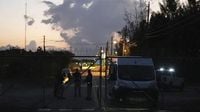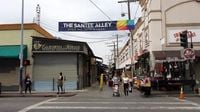Los Angeles has become a focal point of intense immigration enforcement under the Trump administration’s sweeping policies, with impacts rippling through communities, businesses, and local institutions. As federal authorities ramp up deportation efforts, the city’s sanctuary policies, vibrant immigrant neighborhoods, and even schools have found themselves in the crosshairs.
The Trump administration has repeatedly criticized California’s sanctuary law, accusing it of shielding violent criminals. Yet, a detailed examination reveals a more nuanced reality. California’s sanctuary law does not protect unauthorized immigrants convicted of serious crimes, and state prisons have handed over more than 9,000 such individuals to Immigration and Customs Enforcement (ICE) since Governor Gavin Newsom took office in 2019. Notably, two high-profile detainees—Roland E. Veneracion-Enriquez and Cuong Chanh Phan—both convicted of violent offenses, were previously coordinated for transfer to ICE by state authorities.
Veneracion, who served 28 years for rape, was scheduled for handover in May 2025, but ICE canceled his detainer just a day before his release, leading to his freedom and subsequent arrest during a routine ICE check-in weeks later. Phan, convicted of second-degree murder, was released directly into ICE custody in August 2022. These cases highlight the complexity behind the Trump administration’s accusations that California’s sanctuary policies protect the "worst of the worst." State officials maintain that the law strikes a balance, allowing cooperation with ICE for serious offenders while shielding those convicted of minor infractions.
Despite this, immigration enforcement has surged dramatically in Los Angeles and surrounding Southern California. Between June 6 and June 22, 2025, ICE arrested 1,618 immigrants, including many without criminal convictions. Data from the Cato Institute reveals that 65% of detainees since October 2024 have no criminal record, and over 93% were never convicted of violent offenses. This trend is echoed nationally, with about half of the 56,000 immigrants currently held in ICE detention lacking criminal convictions, according to the Deportation Data Project.
The human toll of these policies is palpable in immigrant communities. Santee Alley, a bustling shopping hub in Los Angeles’ Fashion District, has transformed into a near ghost town. Business owners and vendors report a 45% drop in visitors and significant revenue losses. Anthony Rodriguez, president and CEO of the LA Fashion District Business Improvement District, described the impact as “more significant than that of the pandemic lockdown.” Christopher Perez, a store owner with all workers legally present, has seen sales decline by half despite remaining open. Fear of ICE raids has silenced the once vibrant streets, and even rumors of enforcement activity can shutter businesses.
Nearby Olvera Street, a historic Latino neighborhood, echoes this anxiety. Jewelry vendor Vilma Medina reports an 80% drop in sales since early June. Families who should feel safe are gripped by fear, regardless of citizenship status. Meanwhile, undocumented workers like Urbano, a 63-year-old taco truck operator originally from Mexico, continue to work despite the risks, driven by the necessity to provide for their families. Their economic contributions are significant; a recent report from the Bay Area Council Economic Institute estimates that California’s undocumented immigrants pay over $23 billion in local, state, and federal taxes and contribute to 8% of the state’s labor force. Deporting all undocumented residents could shrink California’s GDP by $278 billion, or 9%, underscoring the economic stakes.
These enforcement actions have not spared even schools. On June 17, 2025, ICE agents descended on Ruben Salazar High School in Pico Rivera, adjacent to an elementary school and preschool playground, without providing any legal justification or warrant. School staff requested their departure, but surveillance footage revealed agents urinating on school grounds in public view, a potential violation of California’s laws concerning public indecency near children. The El Rancho Unified School District has demanded a federal investigation, with Los Angeles County Supervisor Janice Hahn condemning the agents’ actions as a “slap in the face” to communities and children. Later that day, ICE agents were filmed aggressively arresting Adrian Martinez, a 20-year-old U.S. citizen, at a nearby shopping center after he protested a co-worker’s detention. Martinez now faces felony charges for interfering with federal agents.
At the federal level, Congress recently passed the "One Big Beautiful Bill" (OBBB), a controversial $170 billion spending package significantly expanding ICE’s budget while cutting vital social programs such as Medicaid and food assistance. The bill passed the House narrowly, with all Democrats and two Republicans opposing it. Proponents hail the bill as a fulfillment of President Trump’s campaign promises, allocating $45 billion to expand ICE detention capacity to nearly 100,000 beds, $14 billion for transportation and removals, and $8 billion to hire 10,000 new deportation officers.
However, critics warn the bill will exacerbate suffering for millions of families and deepen inequality. Sarah Mehta of the ACLU described the legislation as making ICE the largest law enforcement agency in the U.S., with the capacity to detain over 750,000 people, including children and longtime residents in remote detention camps where deaths have already occurred. Maya Wiley of The Leadership Conference on Civil and Human Rights decried the bill as “cruel and corrupt,” highlighting cuts to healthcare, food aid, and mental health services alongside increased deportations. Immigrant advocacy groups like United We Dream Action have vowed to resist these “deadly policies.”
The Congressional Budget Office estimates that the bill could leave 11.8 million more Americans uninsured by 2034 and increase the federal deficit by nearly $3.3 trillion over the next decade. Even some Republicans have expressed concern about the political consequences of slashing social safety nets while boosting immigration enforcement. Senator Thom Tillis warned of painful cuts to Medicaid and critical services in his state.
Within Los Angeles and across the nation, public opinion appears to be shifting. While a 2024 Gallup poll showed 55% of Americans favoring less immigration, a recent NPR-PBS-Marist poll indicates 52% now disapprove of the Trump administration’s harsh enforcement approach. Stories like that of Pastor Maurilio Ambrocio, a Guatemalan immigrant with no criminal record who was detained during a routine check-in and deported after 30 years in the U.S., have touched communities deeply. Neighbors, including some Trump voters, express discomfort with the current trajectory.
As the July 4, 2025, deadline for President Trump to sign the OBBB approaches, Los Angeles stands at a crossroads. The city’s immigrant communities, businesses, and institutions grapple with the consequences of intensified immigration enforcement, sanctuary policies under scrutiny, and a federal government doubling down on a hardline agenda. The resilience of neighborhoods like the Fashion District and Olvera Street will be tested, even as advocates, officials, and residents debate the balance between security, justice, and humanity.





